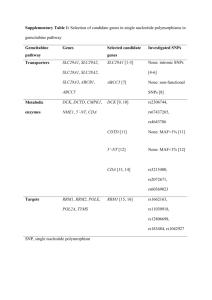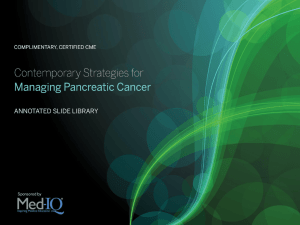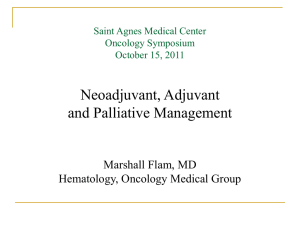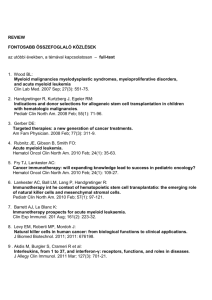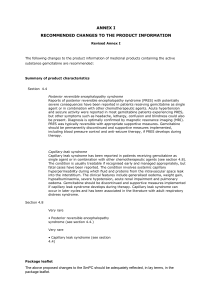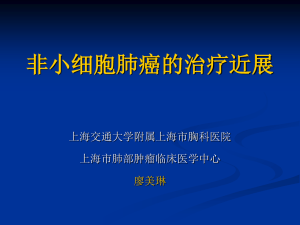New approaches of acute pancreatitis
advertisement
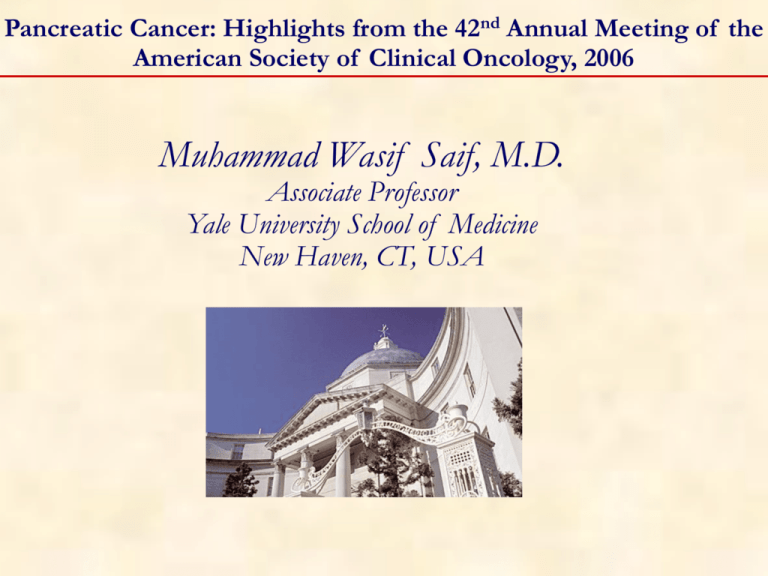
Pancreatic Cancer: Highlights from the 42nd Annual Meeting of the American Society of Clinical Oncology, 2006 Muhammad Wasif Saif, M.D. Associate Professor Yale University School of Medicine New Haven, CT, USA Abstract Despite advances in our understanding of the molecular and genetic basis of pancreatic cancer, the disease remains a clinical challenge. Gemcitabine, the standard chemotherapy for pancreatic cancer, offers modest improvement of tumor-related symptoms and marginal advantage of survival. New approaches, alone and in combination with gemcitabine, are being developed to combat this cancer. Combination chemotherapy trials incorporating gemcitabine, cisplatin, 5-fluorouracil, oxaliplatin, or irinotecan generally show improved outcomes in objective response rates but with little or no improvement in survival in phase III trials. In this article, the author describes the key studies presented at the Annual Meeting of ASCO, held in Atlanta, GA from June 2nd to 6th. The studies discussed here include the following: RTOG 9704 (#4007), FFCD-SFRO study (#4008), meta-analysis of gemcitabine plus cisplatin and gemcitabine plus oxaliplatin vs. gemcitabine alone (GERCOR #4003), and ECOG 6201 (Late Breaking Abstract #4004). Based on the results presented at the annual meeting, it comes to us that patients with locally advanced vs. metastatic pancreatic cancer should be studied separately, better understanding of the biology of pancreatic cancer is mandatory and evaluation of novel agents is crucial. We as oncologist have to change our attitudes towards clinical trials and need to think beyond a trial design such as gemcitabine vs. drug of our choice. Environment within which research is being conducted also has to be changed and last but not the least, access to trials for patients with pancreatic cancer is the key step in the fight against pancreatic cancer. Lessons from ASCO 2006 What did we know already? What we learn? What we miss? What we do next? Lessons from ASCO 2006 What did we know already? What we learn? What we miss? What we do next? Median Survival of Patients with Pancreatic Cancer (Staley’s Classification, 1996) [1] Localized/Resectable 15-19 months 10% Locally Advanced 6-10 months 30% Metastatic/Advanced 3-6 months 60% [1] Staley CA, et al. Pancreas 1996; 12:373-80. Adjuvant Chemo and Chemo-XRT No clear consensus on adjuvant therapy for pancreas cancer GITSG [2]: 43 pts randomized into two groups: XRT/bolus 5-FU weekly 5-FU x 2 years vs. Observation Median survival 20 and 11 months, respectively favoring Chemo-XRT arm ESPAC – 1 [3]: No benefit for Chemo-XRT (P=0.24) Significant overall benefit for Chemotherapy(P<0.001) CONKO-001 [4]: Randomize to: Gemcitabine vs. Observation Disease free survival: 14.2 m vs. 7.5 m (P<0.001) [2] Cancer 1987; 59:2006-10. [3] Neoptolemos JP, et al. Lancet 2001; 358:1576-85. GITSG: Cancer P, 1987 [4] Neuhaus et al. J Clin Oncol 2005, 23(16S):4013. ESPAC-1: Lancet 2003 Locally Advanced Disease Chemo-XRT may improve survival compared to XRT alone GITSG [5] # Pts XRT (60 Gy/10 weeks) only XRT (40 Gy/6 weeks) + 5-FU XRT (60 Gy/10 weeks) + 5-FU 25 83 86 Median Local survival failure rate Survival 1-year 1.5-year 5.3 monts 8.4 monts 11.4 monts 10% 35% 46% 24% 26% 27% 5% 20% 20% Chemotherapy is equivalent to the combination of Chemo-XRT in randomized trials No randomized trials comparing gemcitabine to Chemo-XRT was available till FFCD-SFRO study presented at ASCO 2006 [5] Moertel CG, et al. Cancer 1981; 48:1705-10. Gemcitabine Pivotal Studies: Results Rothenberg [6] Burris [7] Gemcitabine Burris [7] 5-FU Partial response Stable disease Progressive disease 6 (9.5%) 17 (27%) 20 (31.7%) 3 (5.4%) 22 (39.3%) 19 (33.9%) 0 11 (19.3%) 34 (59.6%) Survival: median 6-month 9-month 12-month 3.9 months 31% 15% 4% 5.7 months 46% 24% 18% 4.4 months 31% 6% 2% Time to progression 2.5 months 2.1 months(P=0.0002) 0.9 months Clinical benefit Response 17 (27%) 15 (23.8%)(P=0.0022) 3 (4.8%) [6] Rothenberg ML, et al. Ann Oncol 1996; 7:347-53. [7] Burris HA 3rd, et al. J Clin Oncol 1997; 15:2403-13. (P=0.0025) Developmental Strategies of Gemcitabine-Based Therapies in Pancreas Cancer: 4 Approaches Gemcitabine I In doublets/ Triplets of cytotoxics II With radiation III By fixed dose rate infusion IV With targeted therapies Fixed Dose-Rate Gemcitabine Gemcitabine is a pro-drug that must be phosphorylated to its active metabolites, gemcitabine diphosphate and triphosphate Conversion of gemcitabine to the active triphosphate form is saturable with standard rates of infusion Gemcitabine infused at a fixed dose rate of 10 mg/m2/min optimizes triphosphate accumulation Gemcitabine Metabolism Gemcitabine (dFdC) Cell membrane Deoxycytidine dFdU dFdC deaminase Deoxycytidine kinase dF-dCMP dF-dCDP dF-dCTP dFdC-DNA What Did We Know Before? Advanced Pancreatic Cancer Gemcitabine used 30-min infusion Fixed dose rate (FDR) GemOx Survival Median 1-year 5.7 18% months 7.8 24% months 9.2 36% months [7] Burris HA 3rd, et al. J Clin Oncol 1997; 15:2403-13. [8] Tempero M, et al. J Clin Oncol 2003; 21:3402-8. [9] Louvet C, et al. J Clin Oncol 2005; 23:3509-16. Author Burris [7] Tempero [8] Louvet [9] Lessons from ASCO 2006 What did we know already? What we learn? What we miss? What we do next? Pancreatic Cancer Update Adjuvant I. RTOG 9704 (Abstract #4007) [10] Locally advanced I. FFCD-SFRO study (Abstract #4008) [11] Metastatic I. GERCOR: Gem/cisplatin vs. GemOx vs. Gem alone (Abstract #4003) [12] II.ECOG 6201: 30-min vs. FDR vs. GemOx (Late Breaking Abstract #4004) [13] [10] Regine WF, et al. J Clin Oncol 2006; 24(18S, Part I):4007. [11] Chauffert B, et al. J Clin Oncol 2006; 24(18S, Part I):4008. [12] Louvet C, et al. J Clin Oncol 2006; 24(18S, Part I):4003. [13] Poplin E, et al. J Clin Oncol 2006; 24(18S, Part I):LBA4004. RTOG 9704: Adjuvant Trial in Pancreatic Ca Pancreatic adenocarcinoma, status-post resection: T1-4, N0/N1 July 1998 – July 2002 538 patients in the trial (pancreatic head carcinoma: 381) 442 patients eligible and analyzable (22 no CA19-9, >8 weeks post op.) More T3/4 disease in the Gem arm (P=0.013) Regine WF, et al. J Clin Oncol 2006; 24(18S, Part I):4007. [10] RTOG 9704: Treatment A 5-FU 250 mg/m2/day for 3 weeks Random B Gemcitabine 1,000 mg/m2 weekly for 3 weeks XRT 50.4 Gy + 5-FU (250 mg/m2/day) 5-FU 250 mg/m2/day for 12 weeks Gemcitabine 1,000 mg/m2 weekly for 12 weeks Regine WF, et al. J Clin Oncol 2006; 24(18S, Part I):4007. [10] RTOG 9704: Toxicity Arm A Arm B > Grade 3 Hem 2% 14%* > Grade 3 non-Hem 58% 58% Ability to complete Chemo 88% 90% Ability to complete XRT 86% 88% * No difference in febrile neutropenia Regine WF, et al. J Clin Oncol 2006; 24(18S, Part I):4007. [10] RTOG 9704: Survival Pancreatic head Ca (n=381) Regimen Arm A Arm B (n=187) (n=194) Median survival (months) 20.6 3-yearr survival 21% 36.9 P=0.047 HR=0.79 (95% CI=0.63-0.99) 32% When analysis was inclusive of patients with body/tail tumors (n=442) no significant difference in survival was found (P=0.20). Regine WF, et al. J Clin Oncol 2006; 24(18S, Part I):4007. [10] RTOG 9704: Conclusions Addition of gemcitabine to 5-FU/XRT improves survival in head pancreatic cancer Addition of gemcitabine increases hematologic toxicity, but manageable ? New standard to be considered ESPAC-3 [14]: Randomize to Gemcitabine vs. 5-FU vs. Observation Ongoing [14] National Cancer Research Network Trials Portfolio, 2004. (ISRCTN 37494643) ESPAC–3: Trial Design Patients with adenocarcinoma of the pancreas having ‘curative’ resection Randomization stratified by resection margins 5-FU/FA Gemcitabine FA (20 mg/m2 iv bolus), 5-FU (425 mg/m2 iv bolus) 5 days every 28 days, x6 cycles 1,000 mg/m2 iv infusion once weekly x3 wks, 1 wk rest, x6 cycles Observation National Cancer Research Network Trials Portfolio, 2004. (ISRCTN 37494643) [14] FFCD-SFRO study Phase III trial comparing Chemo-XRT (cisplatin and 5-FU) followed by gemcitabine vs. gemcitabine alone in patients with locally advanced pancreatic cancer Rationale: The GITSG studies have shown a greater survival after 5 FU-based Chemo-XRT than XRT radiotherapy [5] or polychemotherapy alone [15] in patients with locally advanced non metastatic pancreatic cancer Gemcitabine is more active than 5-FU in advanced pancreatic cancer [7] This randomized trial evaluated whether initial Chemo-XRT adds to modern gemcitabine in term of overall survival. [5] Moertel CG, et al. Cancer 1981; 48:1705-10. [7] Burris HA 3rd, et al. J Clin Oncol 1997; 15:2403-13. [15] J Natl Cancer Inst 1988; 80:751-5. Chauffert B, et al. J Clin Oncol 2006; 24(18S, Part I):4008. [11] FFCD-SFRO: Study Design Randomized Phase III Study Randomization Patients with locally advanced nonmetatstaic pancreatic cancer Stratification: • PS (WHO) • Center • Exp surgery or not 5-FU + cisplatin + XRT Gemcitabine Gemcitabine Induction Maintenance Chauffert B, et al. J Clin Oncol 2006; 24(18S, Part I):4008. [11] FFCD-SFRO Study: G 3-4 Toxicities Neutropenia Febrile neutropenia Anemia Thrombocytopenia Nausea/Vomiting Diarrhea Cutaneous 5-FU + cisplatin + XRT 60% 0 3.4% 8.5% 20% 7% 0 Gemcitabine 23% 2% 1.7% 0 10% 0 3% Chauffert B, et al. J Clin Oncol 2006; 24(18S, Part I):4008. [11] FFCD-SFRO Study: Survival Survival 5-FU + cisplatin + XRT Median (months) 8.4 Gemcitabine 14.3 6 months 78% 82% 12 months 24% 51.4% P=0.014 Chauffert B, et al. J Clin Oncol 2006; 24(18S, Part I):4008. [11] FFCD-SFRO Study: Conclusions Gemcitabine alone allowed a significant overall survival in locally advanced nonmetatstatic pancreatic cancer Increased toxicity and decreased maintenance gemcitabine in patients with initial Chemo-XRT may explain this difference Study was stopped before the planned inclusion due to lower survival with initial Chemo-XRT when compared to Gem alone Pooled Analysis of 2 Randomized Trials GERCOR/GISCAD Intergroup Study and a German Multicenter Study Patients (n=503) Gem + platinum compound n=252 Gem alone n=251 ECOG PS = 0 40% 35% Distant metastases 72% 73% Pathological grading = 3 34% 38% Louvet C, et al. J Clin Oncol 2006; 24(18S, Part I):4003. [12] Meta-Analysis: Results GERCOR/GISCAD Intergroup Study and a German Multicenter Study Gem + platinum compound Gem alone P value; HR Progression-free survival 5.5 months 3.5 months P=0.003 HR: 0.66 Overall survival 8.3 months 6.7 months P=0.031 HR: 0.77 Louvet C, et al. J Clin Oncol 2006; 24(18S, Part I):4003. [12] Meta-Analysis: Results in Stratified Patients GERCOR/GISCAD Intergroup Study and a German Multicenter Study Progression-free survival Overall survival Months HR (95% CI) Months HR (95% CI) Stage of disease Locally advanced vs. Metastatic 5.8 3.5 0.66 (0.54-0.81) 10.1 0.68 (0.55-0.82) P<0.001 6.9 P<0.001 5.8 3.5 0.49 (0.15-0.77) 10.6 0.59 (0.49-0.72) P<0.001 6.4 P<0.001 Performance status ECOG 0 vs. ECOG 1-2 Louvet C, et al. J Clin Oncol 2006; 24(18S, Part I):4003. [12] Meta-Analysis: Conclusions GERCOR/GISCAD Intergroup Study and a German Multicenter Study PS 0 pts may achieve a greater benefit in progression-free survival (5.8 vs. 3.5 months; HR 0.49, P<0.001) and overall survival (10.6 vs. 6.4 months; HR 0.59, P<0.001) from treatment with a gemcitabine/platinum doublet This is similar to data reported by Hermann [16] with gemcitabine + capecitabine Stage of disease and PS remain important prognostic factors Careful PS evaluation and stratification is important Specific studies according to stage: locally advanced vs. advanced should be done [16] Herrmann R, et al. J Clin Oncol 2005; 23(16S Part I):LBA4010. Louvet C, et al. J Clin Oncol 2006; 24(18S, Part I):4003. [12] Meta-Analysis: Comparison to Other Gemcitabine-Based Combinations Evidence from Randomized Trials Regimen No. of Survival HR P cases (months) value Gem + platinum-analog vs. 503 Gem alone (meta-analysis) 8.3 6.7 Gem + capecitabine vs. Gem alone [16] Gem + erlotinib vs. Gem alone [17] 7.4 6.0 6.4 5.9 533 530 [16] Herrmann R, et al. J Clin Oncol 2005; 23(16S Part I):LBA4010. [17] Moore MJ, et al. J Clin Oncol 2005; 23(16S):1. 0.77 0.031 0.80 0.026 0.81 0.034 Meta-Analysis: Differences in Groups Gemcitabine administration: 30-min vs. FDR Gemcitabine dose intensity across single agent and combined arms Platinum It analogs (oxaliplatin is not cisplatin) is not know how many pts received XRT prior Impact of these differences cannot be implicated Meta-Analysis: Pitfalls Obvious Extent of disease Performance status It will take a lot of patients to show a difference Oxaliplatin is not cisplatin 30-min gemcitabine is not FDR gemcitabine Pharmacologic basis Toxicity Cost (time of infusion) ECOG 6201: Advanced Pancreatic Cancer March 2003 – March 2005: 833 patients Median follow-up: 5.7 months Males: 53% - PS 0-1: 88% - Metastases: 88% A n=280 Random B n=277 C n=276 Gemcitabine 1,000 mg/m2 30 min i.v. weekly x7 on 1 off , then x3 on 1 off Gemcitabine 1,500 mg/m2 150 min i.v. (10 mg/m2/min FDR) weekly x3 on 1 off Gem 1,000 mg/m2, FDR, day 1 Oxaliplatin 100 mg/m2, day 2 every 14 days Poplin E, et al. J Clin Oncol 2006; 24(18S, Part I):LBA4004. [13] ECOG 6201: Objectives Primary: To determine whether either FDR gemcitabine or GemOx increases survival compared with standard 30-min infusion Secondary: Progression-free survival Toxicity Quality of life Poplin E, et al. J Clin Oncol 2006; 24(18S, Part I):LBA4004. [13] ECOG 6201: Inclusion Criteria Adenocarcinoma No > grade 2 peripheral neuropathy Prior No or poorly differentiated adjuvant Chemo-XRT allowed prior gemcitabine or oxaliplatin ECOG PS > 2 Poplin E, et al. J Clin Oncol 2006; 24(18S, Part I):LBA4004. [13] ECOG 6201: Worst Toxicity Grade Neutrophils Platelets Hemoglobin Nausea Vomiting Infection Peripheral neuropathy Arm A 3 4 19% 15% 12% 0 8% 2% 7% 0 5% 0 2% 1% 0 0 Arm B 3 4 29% 31% 29% 0 15% 3% 8% <1% 5% 1% 5% <1% <1% 0 Arm C 3 4 10% 14% 10% <1% 4% 1% 14% <1% 10% 1% 1% 0 9% 0 Poplin E, et al. J Clin Oncol 2006; 24(18S, Part I):LBA4004. [13] ECOG 6201: Response rate (RECIST) Response Arm A Arm B Arm C Complete/partial 5% 10% 9% Stable disease 29% 29% 29% Progressive disease 26% 24% 24% Unknown 41% 37% 38% Poplin E, et al. J Clin Oncol 2006; 24(18S, Part I):LBA4004. [13] ECOG 6201: Survival and HR Survival Arm A Arm B Arm C Median (months) 5.0 (4.5-5.6) 6.0 (5.4-6.9) 6.5 (6.1-6.8) 1-year 17% 21% 21% 30 min vs. FDR (A vs. B) 30 min vs. GemOx (A vs. C) Survival by disease extent Median (months) HR 95% CI 1.21 1.00-1.45 P=0.053 1.22 0.73-1.05 P=0.045 Locally advanced 9.1 Advanced 5.4 P=0.001 Poplin E, et al. J Clin Oncol 2006; 24(18S, Part I):LBA4004. [13] ECOG 6201: Conclusions Both FDR and GemOx had approximately 1 month longer median overall survival than standard Gem, but not statistically significant Survival outcome with 30 min gemcitabine is persistent Median overall survival: slightly less than other trials: Study design, such as locally advanced and metastatic patients, need to be studied separately FDR and GemOx with increased toxicity: Hematologic, nausea and vomiting with FDR Neuropathy with GemOx ECOG 6201 adds to multiple studies that showed adding another cytotoxic to gemcitabine does not add any benefit to the modest survival by gemcitabine alone Progression-free survival and quality of life not given at the meeting Lessons from ASCO 2006 What did we know already? What we learn? What What we miss? we do next? Promising New Regimens in the Cooperative Groups Gemcitabine + bevacizumab [18] Gemcitabine + cetuximab [19] Median survival of 8.8 months Now in randomized trial vs. gemcitabine alone Promise in this regimen was a 1-year survival rate of 32% Erlotinib data adds encouragement to this trial Now in randomized trial vs. gemcitabine alone Irinotecan + docetaxel [20] Ignored largely, but phase II trial had a 9-month median survival Being tested in a multi-institutional trial with or without cetuximab to confirm this data [18] Kindler HL, et al. J Clin Oncol 2005; 23:8033-40. [19] Xiong HQ, et al. J Clin Oncol 2004; 22:2610-6. [20] Kurtz JE, et al. Hepatogastroenterology 2003; 50:567-70. Lessons from ASCO 2006 What did we know already? What we learn? What we miss? What we do next? Promise from Non-Clinical Trials Better understanding of the biology of pancreatic cancer is emerging New mouse models show promise as potentially more predictive than the old models Newer imaging techniques may help to gauge disease better Palliative care is improving We can’t underestimate this as data suggest that improved pain control alone impacts on survival in this disease Can Oncologists Change? R A N D O M I Z E Gemcitabine Alone Gemcitabine + Your Drug Here What Really Needs to Change? Oncologist attitudes towards clinical trials Environment within which research is being conducted Access to trials for patients What Actions Need to Be Taken to Change? Study design: Locally advanced and metastatic patients need to be studied separately Appropriate trial size: Gemcitabine + cisplatin may have been underpowered Gemcitabine + erlotinib may have been overpowered Advocacy input needs to be sought early: How much benefit is enough to a patient? How much toxicity is too much for a patient? Regulatory environment: Gemcitabine vs. drugs X + Y wins no FDA approval and may never be able to happen Conclusions 30-min Gem vs. FDR? Revisit platinum compounds probably not FFCD another study negating benefit of platinum compounds Need to identify surrogates for survival Accelerate testing new drugs, including targeted agents Move more quickly to adjuvant setting Focus on 2nd Line Rx as most 1st Line regimens failed in the last decade Standardize our approach: design, analysis, reporting Move away from “ONE SIZE FITS ALL” approach to TAILORED patient management References 1. 2. 3. 4. 5. 6. 7. 8. 9. 10. 11. 12. 13. 14. 15. 16. 17. 18. 19. 20. Staley CA, et al. Pancreas 1996; 12:373-80. Cancer 1987; 59:2006-10. Neoptolemos JP, et al. Lancet 2001; 358:1576-85. Neuhaus P, et al. J Clin Oncol 2005, 23(16S):4013. Moertel CG, et al. Cancer 1981; 48:1705-10. Rothenberg ML, et al. Ann Oncol 1996; 7:347-53. Burris HA 3rd, et al. J Clin Oncol 1997; 15:2403-13. Tempero M, et al. J Clin Oncol 2003; 21:3402-8. Louvet C, et al. J Clin Oncol 2005; 23:3509-16. Regine WF, et al. J Clin Oncol 2006; 24(18S, Part I):4007. Chauffert B, et al. J Clin Oncol 2006; 24(18S, Part I):4008. Louvet C, et al. J Clin Oncol 2006; 24(18S, Part I):4003. Poplin E, et al. J Clin Oncol 2006; 24(18S, Part I):LBA4004. National Cancer Research Network Trials Portfolio, 2004. (ISRCTN 37494643) J Natl Cancer Inst 1988; 80:751-5. Herrmann R, et al. J Clin Oncol 2005; 23(16S Part I):LBA4010. Moore MJ, et al. J Clin Oncol 2005; 23(16S):1. Kindler HL, et al. J Clin Oncol 2005; 23:8033-40. Xiong HQ, et al. J Clin Oncol 2004; 22:2610-6. Kurtz JE, et al. Hepatogastroenterology 2003; 50:567-70. Keywords bevacizumab; capecitabine; cetuximab; Cisplatin; Chemotherapy, Adjuvant; gemcitabine; Epidermal Growth Factor; erlotinib; Fluorouracil; oxaliplatin; Pancreatic Neoplasms; Radiation; Radiotherapy, Adjuvant; Receptor, Epidermal Growth Factor; Review; Vascular Endothelial Growth Factor A Abbreviations ASCO: American Society of Clinical Oncology; CONKO: Charité Onkologie - clinical studies in GI cancers; ECOG: Eastern Cooperative Oncology Group; EGFR: epidermal growth factor receptor; ESPAC: European Study Group of Pancreatic Cancer; FA: folinic acid; FDR: fixed dose rate; FFCD-SFRO: Federation Francophone de Cancerologie Digestive and Societe Francaise de Radiotherapie Oncologique; Gem: gemcitabine; GemOx: gemcitabine plus oxaliplatin; GERCOR: Groupe d'Etude et de Recherche en Cancreologie Onco-Radiotherapic; GISCAD: Italian Group for the Study of Gastrointestinal Tract Carcinomas; GITSG: Gastro-Intestinal Study Group; HR: hazard ratio; LBA: late breaking abstract; PS: performance status; RECIST: Response Evaluation Criteria in Solid Tumors; RTOG: Radiation Therapy Oncology Group; XRT: radiation/radiotherapy Acknowledgement The author is grateful to the authors/presentors of the major studies discussed in this review article: Chauffert B. Unite INSERM 517, Faculty of Medicine, 7, Boulevard Jeanne d'Arc, BP 87900, 21079, Dijon, France. bchauffert@dijon.fnclcc.fr (FCCD-SFRO). Louvet C. Institut National de la Sante et de la Recherche Medicale (INSERM), Unit 643 and Institut de Transplantation et de Recherche en Transplantation (ITERT), Nantes, France. christophe.louvet@sat.ap-hop-paris.fr (meta-analysis: GERCOR/GISCAD). Poplin EA. Cancer Center of New Jersey, New Brunswick, New Jersey 08901, USA. poplinea@umdnj.edu (ECOG 6201) Regine WF. University of Maryland School of Medicine, Radiation Oncology Clinical, Gudelsky Tower; Room GGK-17E, Baltimore, MD 21201, USA. wregine@umm.edu (RTOG 9704) Correspondence Muhammad Wasif Saif Section of Medical Oncology - Yale University School of Medicine 333 Cedar Street; FMP 116 New Haven, CT 06520 - USA Phone: +1-203.737.1569 Fax: +1-203.785.3788 E-mail: wasif.saif@yale.edu
